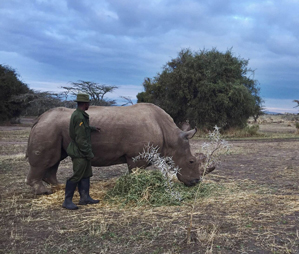Using Virtual Reality to Save the White Rhino
In the basement of the San Diego Zoo’s laboratory complex sits a four-foot-tall, liquid nitrogen-cooled aluminium canister. This “Frozen Zoo,” as the container is known, contains thousands of skin samples taken from a cornucopia of endangered animals, including those of the northern white rhinoceros, a subspecies that is perilously close to extinction. Only four such animals are left in the world. A genetic rescue team at the zoo is working to transform the frozen cells into stem cells that can be used to create the sperm and eggs necessary to grow a new generation of rhinos through in-vitro fertilization.

Time is precious. Nola, the only white rhino left in captivity, at San Diego Zoo Safari Park, is infertile. The other three animals, two of which are female, roam the Ol Pejeta Conservancy in Kenya, protected from poachers by armed guards. These rangers live by the animals’ sides, taking turns to sleep at night.
The American scientists and the Kenyan rangers aren’t the only people working to preserve the white rhinos. Kel O’Neill and Eline Jongsma, a pair of American-Dutch filmmakers, are also hoping to save these animals, not via test tubes or guns, but rather through a virtual-reality headset. The Ark, as their project is known, is a virtual-reality documentary that follows the lives of the last remaining four northern white rhinoceroses, as well as the scientists and rangers working half a world away from one another to preserve the creatures.

“We have a young daughter now, and we’re concerned that there is a whole dimension of the earth as it currently exists that she will not be able to experience in adulthood,” says Jongsma. Nature documentary filmmakers have been recording animals on the brink of extinction as a way to preserve the creatures’ memory for decades. This seems to be the next evolution of that work: capturing 360-degree footage of an animal to allow the viewer to look around, control the point of view, and gain a truer sense of what it’s like to come face-to-face with the animals.
Virtual reality, the documentarians believe, gives viewers “the most direct experience of the story possible.” Sam Watts, a virtual-reality producer for Make Media, agrees. “One of the key strengths of the medium is its ability to create a true feeling of empathy for a particular subject, by allowing the user to be fully immersed within the scene and story that is being told,” he says (see “Will Virtual Reality Reshape Documentary Journalism?”).
It’s a compelling promise. Yet, in the still nascent arena of virtual-reality film production, there are technical aspects of the process that O’Neill and Jongsma are trying to improve upon. “We’re working with a 10-camera GoPro array,” explains O’Neill. “We want the viewer to feel as though they’re a floating ball of consciousness while they watch the piece.” This means that, when the viewer looks down, rather than seeing the tripod on which the 360-degree camera stands or a virtual-reality company’s logo, one instead sees the ground.
This is the first project that O’Neill and Jongsma, who have been making documentaries since 2006, have attempted in the medium. There has been a steep learning curve. “There’s no ‘behind the camera’ anymore,” says Jongsma. “There’s ‘around the camera.’ There’s a lot of hiding, and a lot of letting things play out on their own, in long takes.”
No doubt buoyed by the fact that the film will be supported by mainstream and low-cost virtual-reality headsets such as Google Cardboard and GearVR, The Ark has attracted a committed following of supporters (see, “Google Aims to Make VR Hardware Irrelevant Before It Even Gets Going”). The work has been funded partly by the Tim Hetherington Trust, a private foundation that supports humanitarian and social concern projects throughout the world, and Kickstarter. The latter campaign, designed to fund the pair’s journey to Kenya, raised more than $35,000.
While there are surely few people who would criticize the pair’s ambition to preserve the white rhino in a new and immersive digital medium, the San Diego scientists (who have donated money to the film’s Kickstarter campaign) have come under some criticism for their stem-cell research. O’Neill has no such qualms. “Most people acknowledge that we’re so far beyond ‘natural’ and ‘unnatural’ at this point that we might as well try anything we can to conserve and improve biodiversity here on earth,” he says.
Keep Reading
Most Popular
Large language models can do jaw-dropping things. But nobody knows exactly why.
And that's a problem. Figuring it out is one of the biggest scientific puzzles of our time and a crucial step towards controlling more powerful future models.
How scientists traced a mysterious covid case back to six toilets
When wastewater surveillance turns into a hunt for a single infected individual, the ethics get tricky.
The problem with plug-in hybrids? Their drivers.
Plug-in hybrids are often sold as a transition to EVs, but new data from Europe shows we’re still underestimating the emissions they produce.
Stay connected
Get the latest updates from
MIT Technology Review
Discover special offers, top stories, upcoming events, and more.